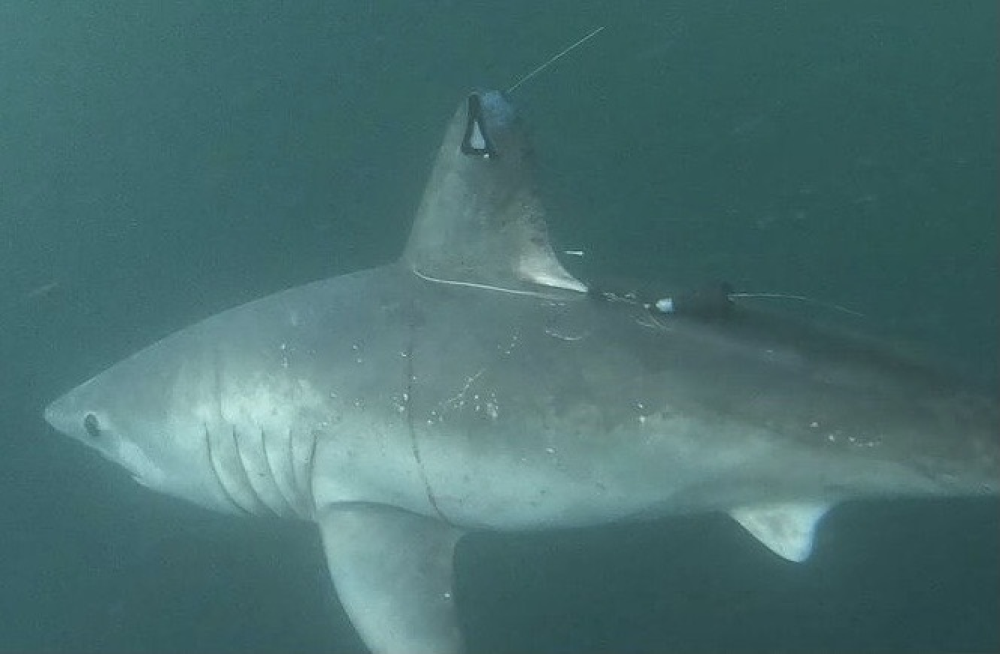A scientific whodunnit recently kicked off in the waters off Cape Cod in Massachusetts where scientists studying porbeagle sharks made a grim discovery: a pregnant female had been eaten by a monstrous predator. The key culprits? The great white and shortfin mako whose reputations precede them, but the murder finvestigation marks the first documented predation event of a porbeagle shark anywhere in the world.
The scandalous tale began back in 2020 and 2022 when scientists were tagging porbeagle sharks (Lamna nasus) in Massachusetts with fin-mounted transmitters and pop-off satellite archival tags (PSAT). Fin mounts can transmit data when the shark is at the water’s surface, while the PSAT continuously records until it pops off (clue’s in the title) and bobs to the surface.
Among the cohort was a pregnant female that measured 2.2 meters long (7.22 feet), a meter or so shy of the maximum for these sharks. She was a catch in more ways than one for the research team, who hoped they’d be able to gather valuable data on the movements of pregnant porbeagles, but it was not to be.
Instead, 158 days after her release, the female’s tag popped up in Bermuda. When the team reviewed the data, they saw that she had been cruising pretty consistently for five months until March 2021. At this time, the temperature data became very consistent at 22 °C (71.6 °F), and she suddenly swam at a much greater depth. For the scientists, it could only mean one thing.
“When a tagged animal gets eaten, you often see patterns in the data that indicate a predation occurred,” lead author Dr Brooke Anderson, a former graduate student at Arizona State University, told IFLScience. “This includes changes in the diving pattern recorded by the tag, as it is now tracking the depth of the predator.”
“You may also see elevated and stable temperatures if the predator is endothermic, as the tag is now recording the stomach temperature of the predator rather than the water temperature. Some tag types even record and send light-level data to researchers, which is one of the easiest ways to identify a predation, as the light levels would go to zero inside a predator’s stomach. However, the tag deployed on our pregnant porbeagle does not send us light-level data, so we had to use all of the other data to solve this mystery.”
In this scenario, a large pregnant porbeagle shark would be a lot of bang for your buck in terms of a meal. So if you think you can pull it off, it may be worth the effort.
Dr Brooke Anderson
So our poor pregnant porbeagle had been eaten by a much bigger predator, and it was only when the tag was excreted around four days later that it was released to the surface. If you’re thinking 2.2 meters is big for a meal, it was, but it may also have been a vital one.
“I think this was likely an opportunistic event,” said Anderson. “Keep in mind that the predation occurred about 300 meters deep in the open ocean, where high-value prey may be sporadic to find.”
“In this scenario, a large pregnant porbeagle shark would be a lot of bang for your buck in terms of a meal. So if you think you can pull it off, it may be worth the effort. However, it’s also possible that large shark predation events could be more frequently discovered with the recent advancements in technology to study species interactions.”

The pregnant porbeagle that was eaten with her tags attached.
Image credit: Jon Dodd
A shocking twist of events, and one that led the team to two key suspects. The consistent temperature pointed towards the guilty party being warm-blooded, and the only candidate large enough to hunt a mature porbeagle in the region is the white shark Carcharodon carcharias and shortfin mako Isurus oxyrhinchus. So, whodunnit?
A tell-tale sign of mako behavior is rapid diving from the sea surface to the murky depths, but this wasn’t what the team saw on the PSAT’s depth data. Instead, the consistent depth tipped suspicion in favor of a great white, which – while one of the greatest apex predators the planet’s ever seen – clearly don’t know how to cover their tracks.
It marks an unexpected and eye-opening predation event for large sharks, and one that adds to the porbeagle’s list of worries as an animal with a relatively slow reproductive rate.
“The most fascinating (and most concerning) thing about this discovery is that the porbeagle that got eaten was pregnant,” said Anderson. “In one instant not only did the population lose a reproductive female, but also all of her developing pups. These are both critical life stages that need protecting, and it appears that predation is another source of mortality that’s been pretty much unknown up until this point.”
The study is published in Frontiers In Marine Science.
Source Link: A Giant Shark's Satellite Tag Wound Up Inside Something Much Bigger